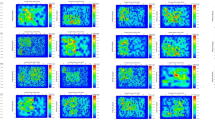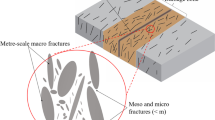Abstract
A model, in which various seismic environmental factors are involved, has been developed in the paper on the bases of relevant data. The environmental factors include the crust structure, lithological conditions, fault plan attitude, the crust stress state, pore-fluid pressure and geothermal conditions, etc. The effect of each of the factors on the tectonic movement energy index has been analyzed. The model calculation results indicate that shear fracture energy of a fault generally increases with depth; it reached a peak value at a certain depth, then turns gradually attenuated. Of all the factors, the effects of pore-fluid pressure and geothermal conditions on the energy index are of prominence. High pore-fluid pressure and high temperature circumstance may result in decline of the peak value of the shear fracture energy curve, making the depths of the peak value and of the bell-waist value deepened. Such effects restrict strong seismic events, but suitable for micro-seismic activity and/or fault creep. The lower limit of focal depth under such an environment is relatively deep. Contrarily, low pore-fluid pressure and low geothermal temperature circumstance result in increase of the peak value of the shear fracture energy curve, and the curve becoming steep. The later circumstance is favorable to the formation of locked segment where possesses high strength and high-energy accumulation. If these two kind of segments are arranged interactively along a fault zone, such arrangement would boost the energy transition among the segments, forming mechanical circumstance of energy highly accumulated in one segment with adjacent segment(s) less-locked. Such contrast of the strength and energy would provide conditions for strong earthquakes with high stress drop. An analysis of the northwest segment of the Honghe fault has provided some evidence for the modeling results.
Similar content being viewed by others
References
Composing Group of Deep Geophysical Exploration, State Seismological Bureau. 1986. Result of Geophysical Exploration of Crust and Upper Mantle in China [M]. Beijing: Seismological Press, 407 (in Chinese).
GAO Jian-li, DING Jian-min, LIANG Guo-pei, et al. 1987. Variation of crustal stress with depth in the basin of North China [J]. Earthquake Research in China, 3(4): 82–89 (in Chinese with English abstract).
Geology and Mineral Resources Bureau of Yunnan Province. 1990. Local Geological Record of Yunnan Province [M]. Beijing: Publishing House of Geology, 1–728 (in Chinese).
Haimson B C. 1978. Hydrofracturing stress measuring method and recent field results [J]. Int J Rock Mech Sci Geomech Abstr, 15: 167–178.
Knapp R B, Knight J E. 1977. Differential thermal expansion of pore fluid: fracture propagation and microearthquake production in hot pluton environments [J]. J Geophys Res, 82: 2 515–2 522.
LIN Yuan-wu. 1994. Fault-weakening effect of reservoir temperature of hot spring and its influence on seismic activities [J]. Acta Seismologica Sinica, 7(2): 321–330.
Pollack H N. 1977. On the regional variation of heat flow, geotherms and lithospheric thickness [J]. Tectonophysics, 38: 3–4.
Patterson M S. 1978. Experimental Rock Deformation — The Brittle Field [M]. New York, Berlin Heidelberg: Springer-Verlag, 1–345.
Rice J R. 1980. Physics of Earth’s Interior [M]. Bologna: Italian Physical Soc, 555–649.
Plenefisch T, Bonjer K P. 1997. The stress field in the Rhine graben area inferred from earthquake focal mechanisms and estimation of frictional parameters [J]. Tectonophysics, 275: 71–97.
WU Qian-fan, XIE Yi-zhen, XIE Zheng-wen, et al. 1984. Preliminary study on geotherm of plain in North China and its neighboring regions [J]. Research of Seismic Science, (1): 29–35 (in Chinese).
XIE Fu-ren, SU Gang, CUI Xiao-feng. 2001. Analysis of recent tectonic stress field in south-western part of Yunnan region [J]. Acta Seismologica Sinica, 14(1): 18–24.
YANG Xu-chong. 1985. A discussion on the regional pore pressure and the hydrodynamic features of Shahejie formations (ES) in Jiyang depression [J]. Petroleum Exploration and Development, (12): 13–20 (in Chinese).
ZHANG Chao, CHEN Lian-wang. 1992. Comprehensive study on stability of deep crust and unstable behavior of earthquake source by both failure mechanism and frictional sliding mechanism [J]. Acta Seismologica Sinica, 5(3): 503–514.
ZHANG Liu. 1994. Study on features of II-shear fracture in rock by triaxil experiments [A]. In: ZHANG Liu ed. Research and Application of Recent Crustal Dynamics [C]. Beijing: Seismological Press, 323–334 (in Chinese).
ZHANG Liu, Rummel F. 1989. Shear fracture energy of rock at high pressure and high temperature [J]. Phys Chem Earth, 17: 99–109.
Author information
Authors and Affiliations
Additional information
Foundation item: Chinese Joint Seismological Science Foundation (No. 9507424).
About this article
Cite this article
Zhang, C., Xie, Fr. & Zhang, Sm. A modeling study on the controlling factors of seismic source distribution and their strength index. Acta Seimol. Sin. 14, 129–140 (2001). https://doi.org/10.1007/s11589-001-0143-y
Received:
Revised:
Accepted:
Issue Date:
DOI: https://doi.org/10.1007/s11589-001-0143-y




